Usa Jingu Shrine: Visit One of Kyushu's Most Beautiful Shrines

Usa Jingu, located in Oita, is one of the most prestigious shrines in Kyushu with a 1300-year history. The sheer beauty of the shrine compound inspires awe. Moreover, it played a major role in the history of Japan's international relations. Read about the highlights of Usa Jingu and how to reach it.
Usa Jingu Shrine - A Must-Visit Destination in Oita
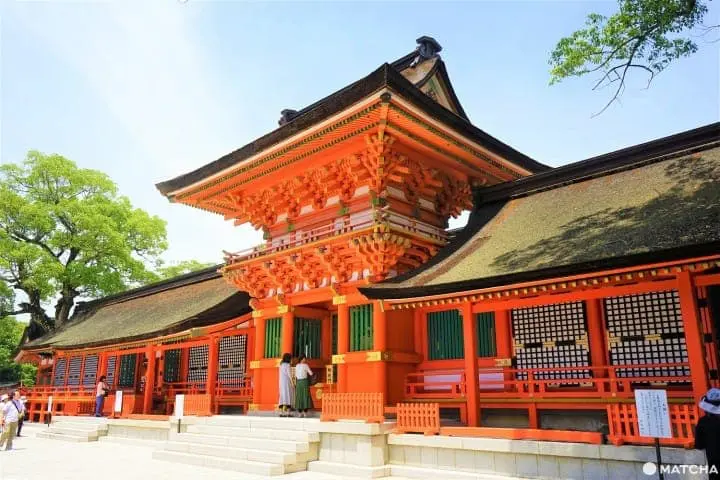
Usa Jingu, located in Usa, Oita Prefecture, is one of Kyushu's most prominent shrines, having played a major role throughout the history of this region. The main shrine hall is a National Treasure of rare beauty.
For anyone traveling to Kyushu, this is a must-visit place! In this article, we introduce the history and highlights of Usa Jingu Shrine, and explain why it is a destination that shouldn't be missed out.
Usa Jingu - Historical Background
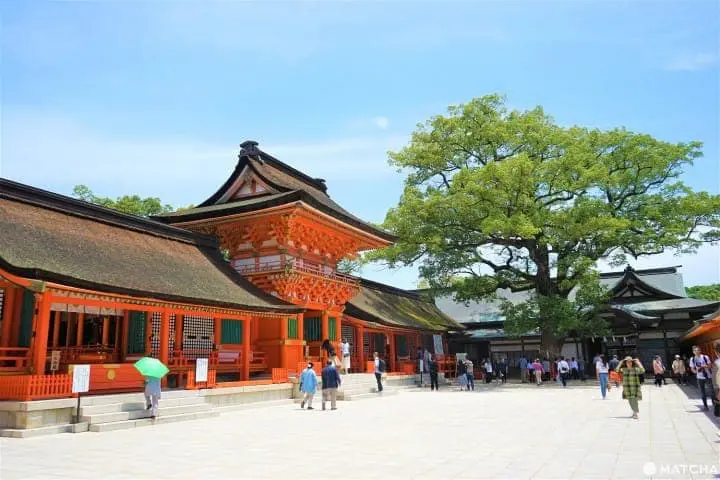
The main shrine hall of Usa Jingu was built in 725 as the earliest shrine dedicated to Hachiman, the spirit of Emperor Ojin (thought to have reigned between 270 and 370) worshipped as the guardian deity of warriors. At present, it is the head of the more than 40,000 Hachiman shrines in Japan.
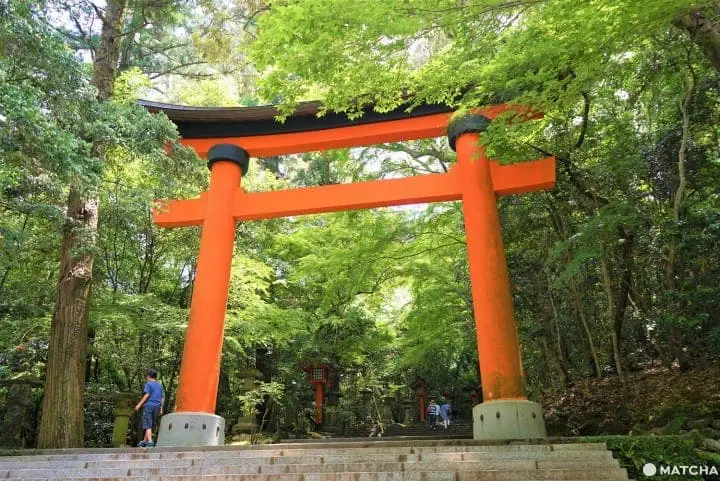
First established on the grounds of a local shrine representing the indigenous nature-oriented, scriptureless Shinto tradition, Usa Jingu gradually embraced Buddhism by inviting Buddhist monks from mainland China and the Korean Peninsula who possessed literacy and knowledge. A Shinto shrine supporting the Buddhist doctrine ever since it was built in 725 (Nara Period) is quite rare. This has become the distinctive feature of Usa Jingu.
This collaboration of Shinto and Buddhism and international exchange led to Usa Jingu attaining unprecedented cultural and political power that deeply influenced the culture of the entire Kyushu region.
Usa Jingu received the protection of both the Imperial Court and the warrior class over the centuries, its influence and power second only to Ise Grand Shrine in Mie Prefecture. Recent studies have shown that, at the peak of its power, Usa Jingu used to own about two-thirds of the entire arable land in Kyushu!
The Highlights of Usa Jingu Shrine
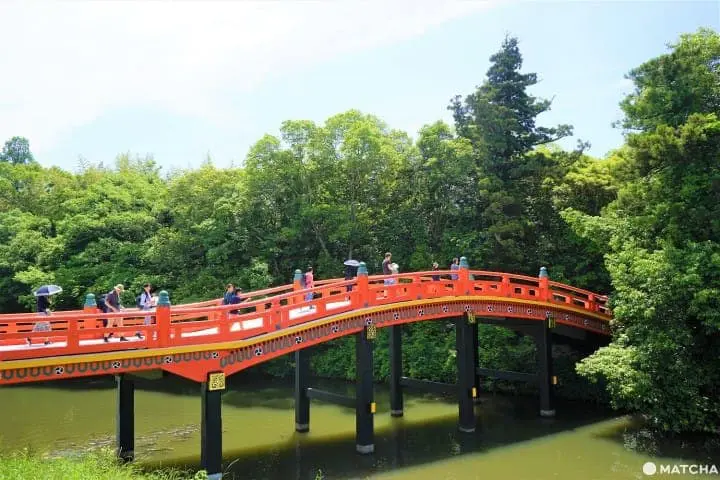
Once you arrive in the parking lot of Usa Jingu, you'll be walking along the Omotesando, the main road leading to the shrine. Cross the Shinkyo, the sacred crimson-red bridge over Yorimo River, and you'll find yourself on the precincts.
Here are five highlights that are worth a closer look for a better understanding of the cultural and spiritual significance of Usa Jingu.
1. The Usa Torii Gate
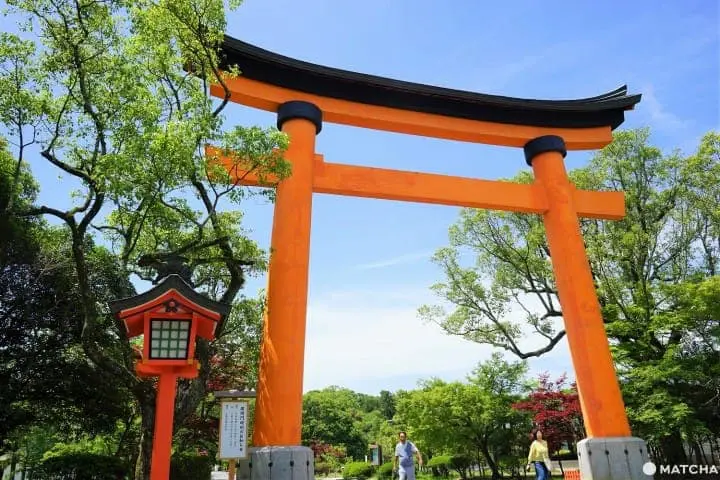
The entrance to any shrine is marked by a torii gate. At Usa Jingu, the torii gates have a distinctive appearance that you won't see at any other shrine in Japan. This is why these gates are called Usa torii.
First of all, the torii has a pointed roof, a sign of high rank of the association with the god Hachiman. You'll notice there is no signboard bearing the name of the shrine. The shape of the torii is specific to Usa Jingu, so it was considered that there was no need to designate the name.
Secondly, the two main pillars stand on stone foundations. And thirdly, black rings encircle the upper end of the main pillars - another feature that is unique to Usa torii gates.

As you enter the precincts, you'll be able to see the shrine offices to the right, across a beautiful pond.
Also, to the right, there is the entrance to the Nishisando, a road that connects Usa Jingu with Dazaifu Tenmangu in Fukuoka, another very powerful shrine. These two shrines have played an essential role in spreading the knowledge and culture imported from the mainland countries.
The Japanese diplomatic missions to Tang China and the Korean Peninsula would use the ports of Kyushu as departure and arrival points. Large religious institutions like Usa Jingu and Dazaifu Tenmangu were flourishing cultural centers that welcomed Chinese scholars and Buddhist monks from the mainland.
2. Saidaimon - The Western Great Gate
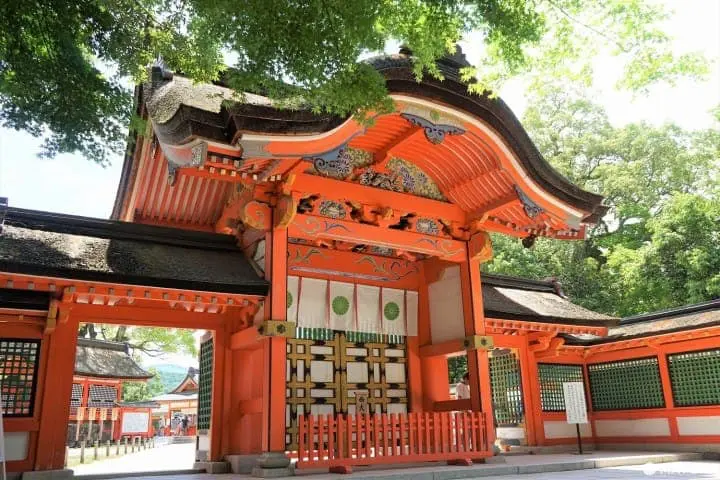
The Saidaimon Gate marks the entrance to the main shrine area. It was rebuilt in the late sixteenth century. Since then it has this gorgeously ornamented style, which can be rarely encountered on the grounds of a shrine.
Notice the Imperial chrysanthemum symbol on the center gates. These gates are reserved for Imperial envoys. Regular visitors use the lateral gates to enter and leave the shrine grounds.
3. Jogu - The Main Shrine Hall
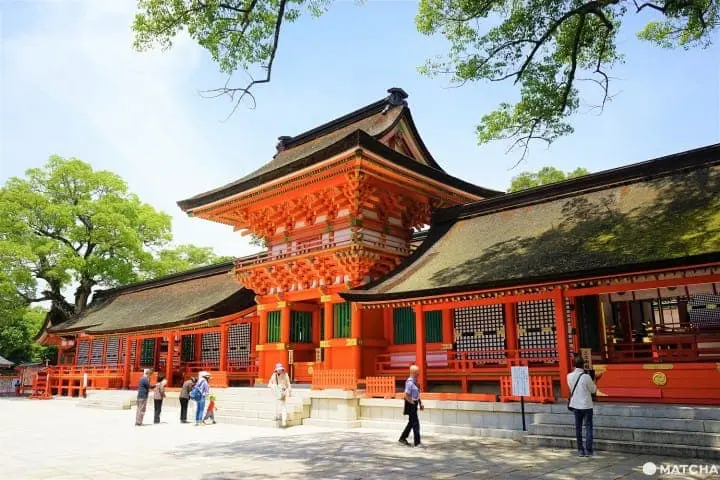
Chokushimon - The Gate of Imperial Emissaries
The main shrine hall of Usa Jingu, called Jogu, consists of three altars. These altars are not accessible to visitors, being located behind the impressive Gate of the Imperial Emissaries (Chokushimon), pictured in the photo above.
The first altar from the left is dedicated to the god Hachiman, the spirit of Emperor Ojin, and was established in 725. Hachiman presides over matters related to war and peace, as well as competitions. This is why athletes frequently visit Usa Jingu.
The central one enshrines Himeookami, the Shinto deity of the original shrine on whose grounds Usa Jingu was built. It was erected in 733. This deity is considered to be a triad of deities; the same triad is worshipped at Munakata Shrine in Fukuoka. They are said to guard the safety of travelers, communication, and happiness.
The altar on the right is dedicated to the spirit of Empress Jingu, mother of Emperor Ojin. It was first built in 823. She is a guardian deity of childbirth and marital relationships.
These three altars are built in a style that is distinctive to Hachiman shrines, each consisting of a front and a back building. The deities are said to reside in the back buildings. The three altars form the main shrine hall, which is designated a National Treasure.
Because they are said to answer a wide range of prayers, these deities are visited by people of all ages.
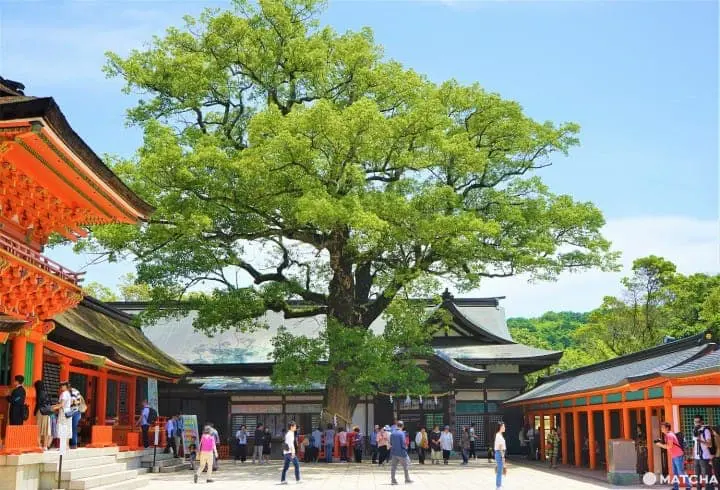
The large camphor tree in front of the main shrine altars is a sacred tree believed to answer prayers that come from the heart.
4. The Altar of Omoto Shrine (Okunomiya)
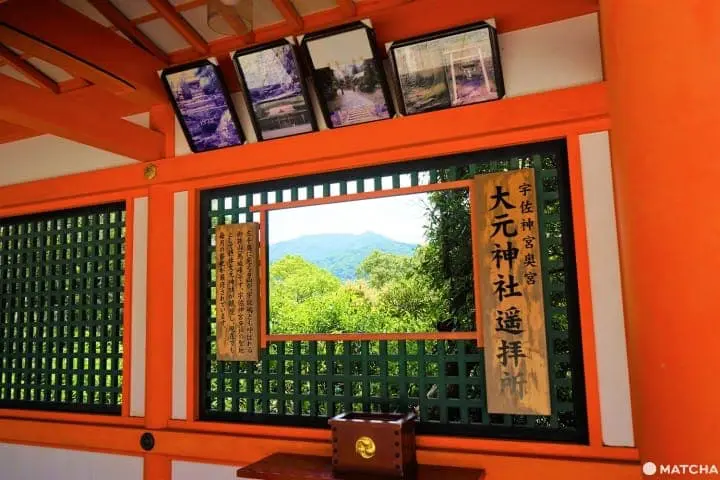
Omoto Shrine is the name of the original shrine that stood on these grounds before Usa Jingu was built here starting from 725. At present, the main hall of Omoto Shrine stands on a mountain to the south of Usa Jingu and is considered the Okunomiya (inner shrine) of the compound.
Visitors to Usa Jingu can make a prayer from the distance to Omoto Shrine at this small altar, located right in front of the Gate of Imperial Emissaries. The "window" that substitutes the worship object offers a view of the sacred mountain whose guardian deity is enshrined at Omoto Shrine.
5. Gegu - The Second Shrine Hall
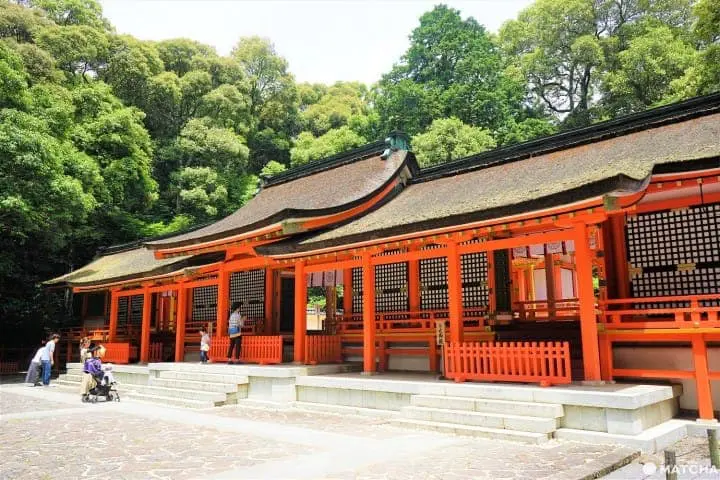
The Gegu is the second main shrine hall of Usa Jingu, located at the foot of the hill on top of which the main shrine is located. It was built in the early 9th century by order of Emperor Saga. While it enshrines the same deities worshipped at the main shrine, the Gegu is considered the place to go for prayers for good crops.
Additional Points of Interest
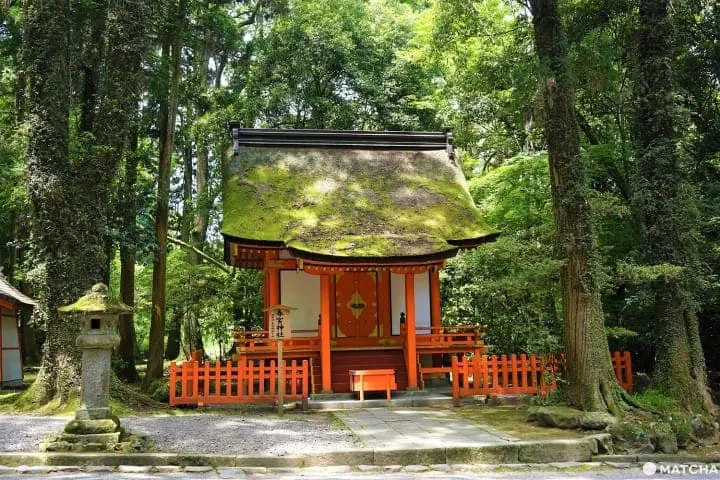
Togu Shrine, dedicated to the son of Emperor Ojin
The precincts of Usa Jingu are quite expansive and dotted with smaller shrines. Each of them enshrines powerful deities and the spirits of Emperors who are regarded as deities.
Take some time to visit the Treasure Hall (Homotsukan), a museum exhibiting precious objects and documents that belong to the cultural heritage of Usa Jingu. A Buddhist temple bell made in the Korean Peninsula and donated to Usa Jingu, precious craft objects and works of art, Noh masks and kimonos - many of the objects on display here are valuable national assets.
Across the Omotesando road from the Treasure Hall is the Noh theater stage of the shrine, used for ceremonies and regular Noh performances. A special Noh performance dedicated to the guardian deities of the shrine is held here yearly on October 21. On this occasion, the actors use the valuable masks and costumes from the shrine collection, which are usually on display in the Treasure Hall.
Access to Usa Jingu Shrine
Usa Jingu can be reached in about 10 minutes by taxi from Usa Station in Usa City, Oita. Usa Station is connected to Oita Station and other major stations in northern Kyushu.
From Oita Airport, take a limousine bus headed for Bungo Takada. It goes directly to Usa Jingu Shrine, and the ride takes about one hour.
Discover the Depths of Kyushu Culture by Visiting Usa Jingu Shrine
A visit to Usa Jingu can be a very special, even spiritual, experience enhanced by the sheer beauty of the shrine compound. The bright red structures create a stunning contrast with the green of the natural oak forest that surrounds the precincts.
Moreover, the history of Usa Jingu allows a deeper understanding of the role played by Kyushu in Japan's international relations with mainland China and the Korean Peninsula throughout the centuries.
Whether you're seeking scenic views, inspiring historical insights or an encounter with the complexity of Japan's religions, Usa Jingu is a must-see in Kyushu.
In cooperation with Usa Jingu and JETRO
Read also
Ramona, English content editor at MATCHA since 2016, has been practicing ikebana flower arrangement (Ikenobo School) and tea ceremony (Omote Senke) since 2012. She arrived in Japan in 2012 as a graduate student with a focus on Japanese literature and performing arts. As a travel editor and writer, Ramona has visited and documented 40 of Japan's prefectures with a focus on art, history, traditional Japanese crafts, and performing arts.

















































![[2026] Top 5 Strawberry Picking Spots in Tokushima, Naruto| Farms and Access Guide for January to May](https://resources.matcha-jp.com/resize/720x2000/2025/03/06-227165.webp)

